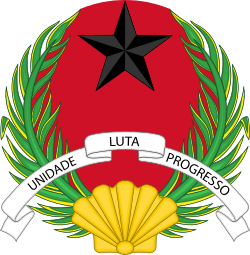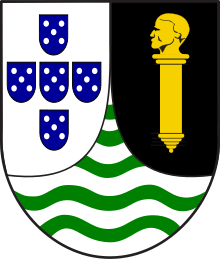Emblem of Guinea-Bissau
The national emblem of Guinea-Bissau was adopted shortly after independence from Portugal in 1973.
| Emblem of Guinea-Bissau | |
|---|---|
 | |
| Armiger | Republic of Guinea-Bissau |
| Adopted | 1994 |
| Crest | None |
| Torse | None |
| Blazon | Gules, in chief a Mullet or five points Sable |
| Supporters | Two wreathes of laurel proper |
| Compartment | A sea shell Or |
| Motto | Unidade, Luta, Progresso (Portuguese: "Unity, Struggle, Progress") |
| Order(s) | None |
Design
Featured prominently is a black star, that is part of traditional Pan-African symbolism, and is often referred to as the Black star of Africa. A seashell at the bottom unites two symmetrical olive branches. The sea shell is symbolism for the location of the country on the West coast of Africa.
The red banner contains the national motto of Guinea-Bissau: that translates to English as "Unity, Struggle, Progress".
Historical coat of arms
In 1935, the Portuguese colonies were officially assigned coats of arms that followed a standard design pattern.[2]
.svg.png) Coat of arms of Portuguese Guinea between May 8, 1935 - June 11, 1951.
Coat of arms of Portuguese Guinea between May 8, 1935 - June 11, 1951..svg.png) Coat of arms of Portuguese Guinea from June 11, 1951 to September 24, 1973.
Coat of arms of Portuguese Guinea from June 11, 1951 to September 24, 1973. Lesser coat of arms between May 8, 1935 - September 24, 1973.
Lesser coat of arms between May 8, 1935 - September 24, 1973..svg.png) Coat of arms of Guinea-Bissau (1973-1994)
Coat of arms of Guinea-Bissau (1973-1994) Coat of arms of Guinea-Bissau (1994–present)
Coat of arms of Guinea-Bissau (1994–present)
gollark: I'm considering somehow coordinating it with the *other* reactor which burns TBU oxide.
gollark: Otherwise it turns off.
gollark: Basically, the top one transmits the powercell's fullness level (obtained via a computercraft thing since comparators appear to not work) and the bottom one receives that, reads the reactor's buffer level (it was meant to be heat but somehow I just get the RF output buffer level), and if the powercell is below full and the buffer empty it turns the reactor on.
gollark: Some screenshots of the controllers.
gollark: TIS-100 is a weird massively-parallel architecture of nodes running simple assembly programs communicating with each other.
References
- "Portaria 8098: Aprova as ordenações das armas das colónias que, nos termos da Constituïção e do Acto Colonial, formam o Império Colonial Português", Diário do Govêrno n.º 104/1935, Série I de 1935-05-08, 597-599 (in Portuguese)
- published in the Diário do Govêrno[1]
This article is issued from Wikipedia. The text is licensed under Creative Commons - Attribution - Sharealike. Additional terms may apply for the media files.